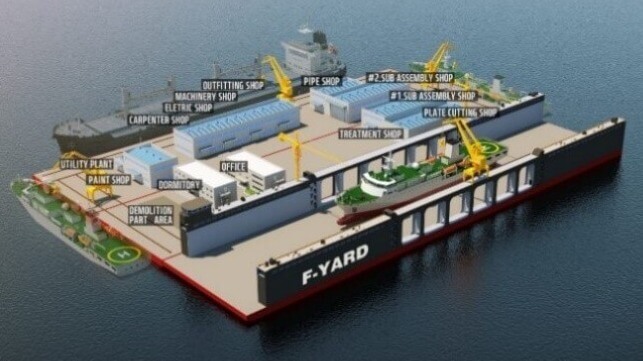The Floating Shipyard Revisited: A Mobile, Modular Yard for Repairs

Since “The Concept of the Floating Shipyard" was published earlier this year, we have developed a new model with South Korean company KR Engineering Co. Ltd. It contains two main parts: The first is the Lightweight Modular Causeway System (LMCS), which was initially invented by the U.S. Army for a wet gap crossing, then developed as a floating platform. The second is a self-propelled floating dock (or heavy lift vessel), which will be transported to collect the vessel from its nearby location. Both combinations have standard mooring arrangements.
This new model has a unique layout that can serve a wide range of vessels and offshore platforms. It would be paired with better manpower planning by dividing the workforce into two teams, a diagnosis team and a repair team. The use of new remote inspection technology would improve diagnostics before calling in above-water and dive repair teams for action.
When it comes to a bigger scale of repair, then the ISO containerized layout unlocks space restrictions and gives high flexibility to the F-Yard to fit the purpose of each repair faster. During F-Yard mobilization, the LMCS will be folded and stored on the main deck of the dock with the containers.
In addition, adopting the hybrid of Lean and Agile in a Leagile methodology plays a significant role in tactical decisions for an uncertain scope of repair. Ensuring a robust supply chain through Early Supplier Involvement (ESI) is vital to overcome the high percentage of unforeseen scope. IoT and digital twin technology are also essential in resource optimization and project control.
Financial Study
The turn-key competitive element of F-Yard is the capability of shifting from one location to another. ROI in the financial study demonstrates a promising investment based on a geographic scan with actual cases.
Another factor is acquiring a multi-skill, two-shift crew focusing on operating the floating unit and supervising the assigned workforce. Lifestyle and utilities would be the same as those for a ship’s crew who live on board. In the event that there is a major repair, then outside contractors could be hired along with an accommodations barge for extra capacity.
 Ahmed Samir Ghowel, MSc, MRINA, IEng, PMP, MBA has 17 years of experience in shipyards and an MSc from Liverpool University in Construction Project Management. He is currently doing his Ph.D. in Shipyard Lean Transformation at UTM Malaysia. The author is open to partnership inquiries and may be reached at [email protected].
Ahmed Samir Ghowel, MSc, MRINA, IEng, PMP, MBA has 17 years of experience in shipyards and an MSc from Liverpool University in Construction Project Management. He is currently doing his Ph.D. in Shipyard Lean Transformation at UTM Malaysia. The author is open to partnership inquiries and may be reached at [email protected].
The opinions expressed herein are the author's and not necessarily those of The Maritime Executive.
